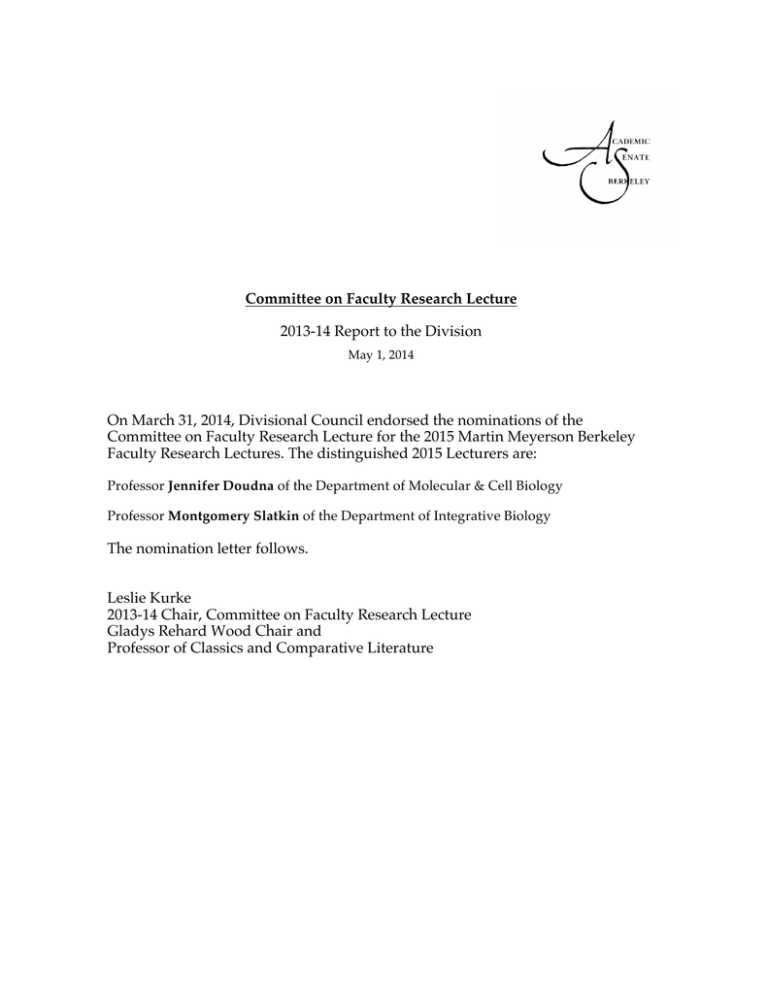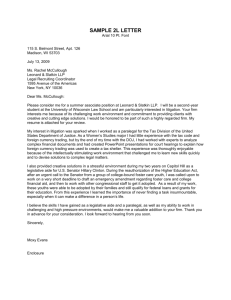2013-14 Report to the Division
advertisement

Committee on Faculty Research Lecture 2013-14 Report to the Division May 1, 2014 On March 31, 2014, Divisional Council endorsed the nominations of the Committee on Faculty Research Lecture for the 2015 Martin Meyerson Berkeley Faculty Research Lectures. The distinguished 2015 Lecturers are: Professor Jennifer Doudna of the Department of Molecular & Cell Biology Professor Montgomery Slatkin of the Department of Integrative Biology The nomination letter follows. Leslie Kurke 2013-14 Chair, Committee on Faculty Research Lecture Gladys Rehard Wood Chair and Professor of Classics and Comparative Literature UNIVERSITY OF CALIFORNIA, BERKELEY BERKELEY • DAVIS • IRVINE • LOS ANGELES • MERCED • RIVERSIDE • SAN DIEGO • SAN SANTA BARBARA • SANTA CRUZ FRANCISCO UNIVERSITY OF CALIFORNIA DEPARTMENT OF CLASSICS 7233 DWINELLE HALL # 2520 BERKELEY, CALIFORNIA 94720-2520 PHONE 510-642-2054 FAX 510-643-2959 March 21, 2014 TO: Elizabeth Deakin Chair, Berkeley Division, Academic Senate FROM: Leslie Kurke Chair, Committee on Faculty Research Lecture RE: Nominations of Martin Meyerson Berkeley Faculty Research Lecturers for 2015 The Committee on Faculty Research Lecture met on February 19, 2014 to consider nominations from many disciplines at the University. Our charge was to find two distinguished scholars whose research has opened up new fields or made distinctive and original contributions to existing fields. We looked as well for candidates who were nationally and internationally recognized and who represent the distinctive and distinguished research that takes place across the disciplines here and which has established our reputation for excellence throughout the world. In addition, we considered the ability of the candidates to present an exciting lecture to a broad audience. The committee unanimously recommends that the 2015 Martin Meyerson Berkeley Faculty Research Lectures be delivered by Jennifer Doudna of the Department of Molecular & Cell Biology and Montgomery Slatkin of the Department of Integrative Biology. This represents a somewhat unorthodox choice, in that both of the recommended scholars are in the sciences (indeed, both in biology!). But this was the result of the fact that we had an exceptionally strong pool of nominees this year in the sciences, and that both of the scholars recommended for next year have recently made extraordinary, breakthrough discoveries—discoveries that it seems timely to acknowledge right now (see more extensive discussion of each below). The committee also felt that the work of these two scholars was nicely complementary: Slatkin has made a remarkable discovery of content, about the nature and origins of humanity itself, whereas Doudna has created a remarkable tool to manipulate genetic material in living cells with great precision. And while it is unusual to have two lecturers in one year from the same side of the Humanities-Social Sciences vs. Sciences divide, it is not unprecedented: the committee notes similar configurations for the years 1974 (both speakers scientists) and 1983 (both speakers from Humanities-Social Sciences). The committee reasoned that this was a unique opportunity to recognize and celebrate new discoveries of unparalleled importance, while we are also committed to redressing the balance in the near future, possibly even next year, with two Humanities-Social Sciences nominations if worthy candidates are put forward by their departments. Montgomery (Monty) Slatkin studies the genetics of human populations, thereby aiming to understand patterns and processes relating to genetic variation among individuals. Slatkin is a founder of the field of modern population genetics, which provides the theoretical basis of evolutionary theory and is also at the core of much modern research in human disease genetics. Thus, for example, Slatkin’s work has been very important in understanding the distribution and Leslie Kurke 4331 Dwinelle Hall Tel. 510-642-2054 email: kurke@berkeley.edu spread of viral pathogens such as HIV. In addition, he has been instrumental in the development of methods and theory that have allowed medical researchers to make more powerful designs when detecting mutations underlying heritable diseases such as Type II Diabetes and several psychiatric disorders. Slatkin is also well-known for his analysis of human genetic diversity and the development of methods to reconstruct the migration patterns of early human populations. He has most recently applied these methods to understand interbreeding events between ancient (Neanderthals and Denisovans) and modern humans. Slatkin’s research group was part of an international team that “resurrected” the Neanderthal genome. Although long extinct, it was possible to obtain complete genome sequence information using DNA extracted from the toe bone of a human fossil that dates back 50,000 years. The analysis of the Neanderthal genome resolved a long-standing controversy, namely, was there interbreeding between ancient and modern humans? The answer is a definitive yes: approximately 2% of the genes in our genomes are derived from ancient human populations that were thought to be extinct. Slatkin and his students played a major role in this unexpected and startling revelation about our origins. Slatkin’s groundbreaking research has garnered him a host of prizes and honors. Just a couple of examples: in 2000, he received the Sewall Wright Award of the American Society of Naturalists, and in 2009-10, in recognition of his fundamental analyses of the newly sequenced Neanderthal genome, he was awarded the Newcomb Cleveland Prize of the American Association for the Advancement of Science. Finally, Slatkin is by all accounts an excellent communicator, wellknown for his elegant, witty, and accessible public lectures. Jennifer Doudna studies small RNAs that control a variety of developmental and disease processes in animal cells and bacteria. She is well known for her studies of “catalytic” RNAs that function as enzymes. Early in her career, Doudna elucidated the structures of protein enzymes, such as Dicer, that are responsible for the genesis of small RNAs. For these achievements Doudna was elected to the National Academy of Sciences in 2002. Since then she has had an even greater impact on the biomedical research community by discovering how bacteria use small RNAs to protect themselves against infections. In particular, Doudna and her students collaborated with Emmanuelle Charpentier of Umea University to characterize Cas9, an enzyme that uses small RNAs to recognize and alter specific DNA sequences within any plant or animal genome. In a period of just two years, the so-called CRISPR system developed from this research has become the method of choice for “genome editing,” the controlled, rational modification of genetic information. The method is powerful and transformative; over 400 scientific papers on the CRISPR method have been published since Charpentier and Doudna first announced their findings in August 2012. Doudna’s extraordinary discoveries have already been recognized by her election to the National Academy of Sciences (2002), the American Academy of Arts and Sciences (2003), the American Association for the Advancement of Science (2008), and the Institute of Medicine of the National Academies (2010). She is also the recipient of multiple national and international awards, culminating most recently in the 2014 Lurie Prize in the Biomedical Sciences from the Foundation for the National Institutes of Health. We feel Berkeley should be “ahead of the curve” in acknowledging Doudna’s remarkable discovery before others do. Doudna’s colleagues and letterwriters emphasize that she is a dynamic and effective speaker, who will give an exciting lecture on her recent pathbreaking discovery. In sum: we are proud to be able to recommend two such remarkable scholars as Martin Meyerson Berkeley Faculty Research Lecturers for 2015.





